By Johna Till Johnson
Photos by Vladimir Brezina
The lively school of fish flashing by probably should have been a clue.
On our kayak trip several weeks ago, we decided to pay a visit to the Gowanus Canal. I know it seems crazy to paddle on a heavily-polluted Superfund site, but we both have a secret fondness for blasted industrial landscapes. And the canal also features charming, idiosyncratic quirks: festive murals, and a houseboat or two.
Or at least it did, upon our last visit. We hadn’t seen it since just before Superstorm Sandy. Then, the mood had been somber, filled with foreboding and a sense of upcoming loss. We feared what the storm would do to the places we’d come to love, Gowanus among them.
True to our fears, Sandy kept us off the water for months, and in the nearly three years since then, we didn’t make it back to Gowanus to see how it survived. So this trip was very much an exploration: How much had Sandy destroyed? And what was left?
Things had definitely changed, as it turned out—but not exactly in the way we expected.
 We paddled down to the mouth of the canal, riding with the current. Up ahead was the Red Hook Grain Terminal, an eerie building, blackened by mold, bearing graffiti, abandoned for over 50 years. I was pleased to see it still standing, not notably worse for the wear since Sandy.
We paddled down to the mouth of the canal, riding with the current. Up ahead was the Red Hook Grain Terminal, an eerie building, blackened by mold, bearing graffiti, abandoned for over 50 years. I was pleased to see it still standing, not notably worse for the wear since Sandy.
Then it was time to enter the Gowanus Canal proper. Just as I paddled up to the archway leading into the canal, a brilliantly-colored butterfly flitted by. An omen! Perhaps signifying Gowanus’ metamorphosis? But into what?
The next thing I noticed were the silvery flashes below my boat. A school of fish swam by—finger-sized and glittering in the murky water. Fish living in the Gowanus Canal—who’d have expected that?
As we paddled along in bright sunlight, paddles splashing into the green water, we saw that much had changed. But somehow the fundamental quirky, whimsical essence of the place had stayed intact.
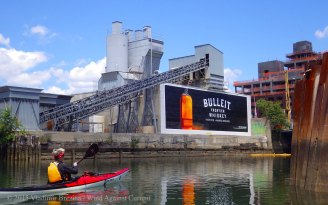 The houseboats we’d appreciated—with murals and whimsical names—were gone. But the chartreuse birdboxes lining the canal were still intact—and inhabited, we were happy to see. And although there was plenty of new construction going on (including of a new high-rise apartment building), there was still plenty of the old gritty industrial landscape on display.
The houseboats we’d appreciated—with murals and whimsical names—were gone. But the chartreuse birdboxes lining the canal were still intact—and inhabited, we were happy to see. And although there was plenty of new construction going on (including of a new high-rise apartment building), there was still plenty of the old gritty industrial landscape on display.
And what was that, dead ahead of us? At first it looked like flags fluttering in the summer sky. But as we paddled closer it turned out to be a forest of whirling windmills—improbably planted in the parking lot of a new Whole Foods store. We later discovered this was Brooklyn’s first Whole Foods. And its coming had, it seemed, been highly polarizing: many residents felt it marked the end of Brooklyn’s artistic hipster vibe, while others appreciated the convenience.
 Our take? Well, as we paddled closer to the parking lot, we discovered something else: On the opposite side of the canal was a multistory, colorfully painted mural, still under construction, as two girls in shorts carefully brushed paint on the wall. No, we decided: Despite the emergence of the dreaded “yuppiemart”, Gowanus wasn’t going to lose its funky character. (A contrary view: these murals are merely “putting lipstick on a pig” by the local powers-that-be.)
Our take? Well, as we paddled closer to the parking lot, we discovered something else: On the opposite side of the canal was a multistory, colorfully painted mural, still under construction, as two girls in shorts carefully brushed paint on the wall. No, we decided: Despite the emergence of the dreaded “yuppiemart”, Gowanus wasn’t going to lose its funky character. (A contrary view: these murals are merely “putting lipstick on a pig” by the local powers-that-be.)
A bit farther on, however, we drifted past the complex of partially-constructed glass-and-concrete apartment buildings, sprawling along the banks of the canal. The developers no doubt refer to them as “luxury waterfront buildings”—so long as your idea of “luxury” doesn’t include windows that actually open. Because for better or worse, another thing that hasn’t changed about the canal is the smell! (The buildings’ basements are also likely to flood with fetid canal water during the next Sandy, or even a substantial rainstorm.)
All too soon, we arrived at the end of the canal, and it was time to turn back. Schools of fish accompanied us on our paddle back (although, alas, I didn’t see any more butterflies).
As we popped out of the end of the canal, Vlad said, “I’d like to go take a look at that ferry docked behind the grain terminal.”
What ferry?
Sure enough, there was a ferry-turned-houseboat, windows open to catch the breeze, with curtains fluttering and the glimpse of a hammock or two strung inside. Houseplants adorned the upper deck, and as we paddled down its length, we caught sight of an elegant, wood-paneled interior.
It was the Yankee, more than 100 years old, which had been variously a passenger ferry, military transport in both world wars, and now historic landmark. It is currently owned by a pair of artists, who managed it in its previous port at Hoboken, and then, when it was threatened with eviction, shepherded it to safety just outside the mouth of the Gowanus.
In Hoboken, Yankee served as a floating bed-and-breakfast. It won’t be returning to the role of “boatel” in Brooklyn, but will instead serve as a public museum and meeting space. According to its Facebook page, it continues to undergo restoration.
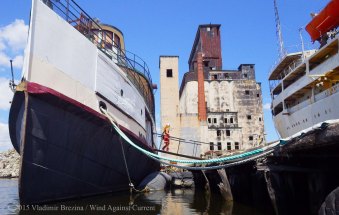 As we watched, a girl with colorfully-streaked hair bicycled up to the ferry. Leaving the bike unchained, she disappeared inside for a bit. Then she emerged, gave us a cheerful wave, and pedaled off.
As we watched, a girl with colorfully-streaked hair bicycled up to the ferry. Leaving the bike unchained, she disappeared inside for a bit. Then she emerged, gave us a cheerful wave, and pedaled off.
We paddled down to the far end of the ferry where we discovered yet another surprise.
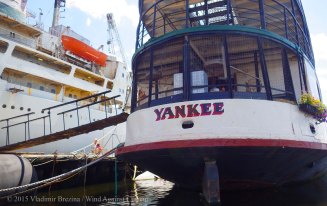 “Vlad, something’s moving!” I said excitedly. Sure enough, there was the bobbing brown head of… a chicken! Soon joined by another one, this one black and white. From their perch in the stern of the boat high over our heads, they eyed us cautiously. But when I started to talk to them, they leaned towards me eagerly—they clearly were socialized to like people. And that’s probably what the girl had been doing on her short visit: feeding the chickens.
“Vlad, something’s moving!” I said excitedly. Sure enough, there was the bobbing brown head of… a chicken! Soon joined by another one, this one black and white. From their perch in the stern of the boat high over our heads, they eyed us cautiously. But when I started to talk to them, they leaned towards me eagerly—they clearly were socialized to like people. And that’s probably what the girl had been doing on her short visit: feeding the chickens.
So, is Gowanus gentrifying? Yes… and no. Sure, there are flashy apartment buildings and a Whole Foods. But there are still murals, artists, and a one-of-a-kind ferry… enough to keep the canal interesting and inspiring to us for years to come.
_______________________________________________________
More photos from the trip (click on any photo to start slideshow):
Even more photos are here.

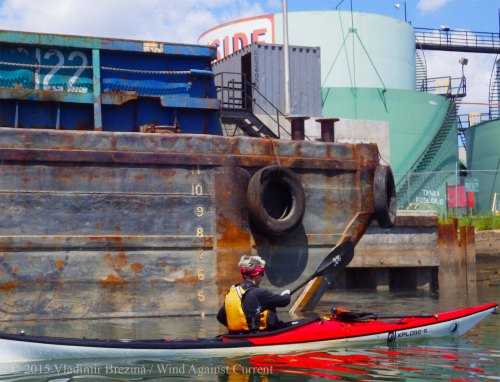

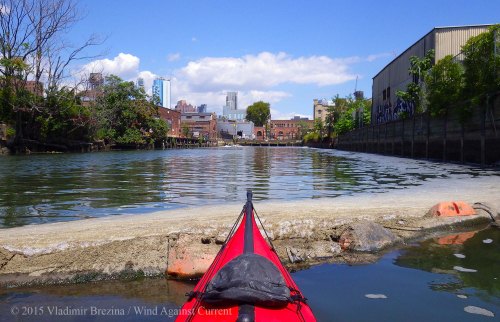





















































Very cool. Haven’t seen the Yankee since it was on the west side of Manhattan. Wikipedia is remarkably up to date on it: https://en.wikipedia.org/wiki/Yankee_(ferry)
Might the schools you saw be killifish? They’re apparently famed for resistance to toxins or have too short a lifespan for some effects to take hold.
LikeLike
They might have been killifish, but their appearance does not quite match the photos of killifish I’ve seen. They were a couple of inches long, quite skinny and long, gray or green colored, swimming in many schools of hundreds…
LikeLike
Amazing to hear about its transformation. And the Yankee has such fascinating history. My first thought was, “those are the lines of a statue ferry”.
LikeLike
And in fact, among many other roles, the Yankee served for part of its life as as an Ellis Island and Statue of Liberty ferry :-)
LikeLike
Great post. I love the pictures that show the scale of the boats/buildings to your kayak, especially the third one with the grain terminal.
LikeLike
Almost everything is bigger out there than a kayak! Kayaks are at the bottom of the food chain :-)
LikeLiked by 1 person
Really enjoyed taking this watery adventure along with you. I used to live near the Gowanus and always found it fascinating. Would love to read and see more of your adventures into the urban underbelly of New York.
LikeLike
Well, Newtown Creek and perhaps the Bronx River are due for a revisit…
LikeLike
What an adventure. I can only imagine the odor, what brave canal-farers you are. And what a cool house boat!
LikeLike
Yes, finding it was definitely the high point of this trip!
LikeLiked by 1 person